Ohio is home to hundreds of species of spiders. Some you may encounter daily, others you may never see. Not all spiders are dangerous, with most giving a painful bite that can be treated at home.
The common spiders you may encounter in Ohio, from the most common to least common, include:
Table of Contents
1. Bold Jumping Spider
Scientific name: Phidippus audax
Common name: daring jumping spider, bold jumping spider.
The bold jumping spiders are probably the most encountered in Ohio.
It is a small spider that can jump more than four times its body length. They use their fast speed and outstanding jumping ability to ambush prey and escape predators. They are not easy to catch, which reduces the risk of being bitten.

They will bite, but their venom is no worse than a bee sting to humans.
They are black spiders with a white line that runs across the upper part of the abdomen with two white dogs close to the back. They have hair on their legs and pedipalps.
2. Tan Jumping Spider

Scientific name: Platycryptus undatus.
Common name: tan jumping spider.
The second most encountered spider is the tan jumping spider, belonging to the same family as the bold jumping spider, Salticidae family.
They are fast and jump in a rapid-fire motion to ambush their prey. They do not spin webs to entrap prey. Their webs are their retreat and a safe place to store and eat any prey they catch.
These hairy light brown jumping spiders are not inclined to bite unless handled roughly.
3. Orchard Orbweaver

Scientific name: Leucauge venusta.
Common name: Orchard orbweaver.
The orchard orbweaver is a long-jawed orbweaver that is common in Ohio. They create orb-shaped webs where the spider hangs upside down in the center.
These spiders have leaf green sides and legs with the underside being yellow and black and the top being silver with black and brown streaks. They have bright orange, red or yellow spots at the back of the abdomen.
4. Yellow Garden Spider

Scientific name: Argiope aurantia.
Common name: yellow garden spider, black and yellow garden spider.
Yellow garden spiders are also known as black and yellow garden spiders, which were first described in 1833.
They are common in Ohio and can be identified by the black and yellow markings on their abdomens and a white cephalothorax (head space which the legs attach).
The female yellow garden spider can grow to 1.10 inches (28mm) in body length, with the male being smaller and growing to around 0.35 inches (9mm) in body length.
They will bite if you disturb or harass them. Their bite is harmless and will cause stinging, redness, and swelling at the bite site, which can be managed with a cold compress.
5. Banded Garden Spider

Scientific name: Argiope trifasciata
Common name: banded garden spider, banded orb weaving spider.
Banded garden spiders build webs between the plants found in garden beds. They sit in the center of their web, hanging upside down, waiting for prey to get ensnared in their sticky web.
They vary in color from black with white and yellow banding to red/brown with white banding. Their legs are banded in the same colors as their bodies. They have a round abdomen and furry neck region, which has silver hairs.
6. Dark Fishing Spider

Scientific name: Dolomedes tenebrosus.
Common name: dark fishing spider.
The dark fishing spider can grow to 90mm in leg span. Females are larger than males and can grow to 26mm with males being half the size.
They are light or dark brown with chevron markings and light stripes. Their legs are banded with brown and black changing to red/brown or black on the tibia.
They live in trees and wooded areas.
7. Spotted Orbweaver

Scientific name: Neoscona crucifera.
Common name: Hentz orbweaver, spotted orbweaver, barn spider.
The spotted orbweaver spins a orb-shaped web that can be up to two feet in diameter.
They vary in color with some being tan, some orange/red, and others being yellow/brown. The abdomen markings can also vary with some having light patterns and others having dark zigzags down their sides. They are covered in bristles.
Their preferred habitat is fields, gardens, backyards, woodlands, and parks.
These spiders are rarely seen during the day, as they are nocturnal.
8. American Nursery Web Spider

Scientific name: Pisaurina mira.
Common name: American Nursery Web Spider.
American nursery web spider has a long abdomen and eight eyes, which are arranged in two rows. The first row is a straight line and the second is a U shape. Their coloration can range from a dark band on the abdomen to two rows of spots.
They are wandering hunters and are usually found between fields and woods where they prefer shrubs, bushes, and long grass.
9. Furrow Orbweaver

Scientific name: Larinioides cornutus.
Common name: furrow spider, furrow orb weaver, foliate spider.
The furrow orbweaver has a bulb-shaped abdomen with females growing to around 14mm in body length with a leg span of 35mm and males being smaller, growing to 9mm in body length.
They can range from gray to red or black with the carapace being a lighter shade with an arrow shape that points towards the head. Their legs also have the arrow pattern.
They have eight eyes, comprising of a single row of six eyes and an additional pair of eyes just above that.
Furrow orbweavers prefer moist environments and are almost always encountered close to water.
10. Spined Micrathena

Scientific name: Micrathena gracilis.
Common name: spined micrathena, castleback orbweaver.
This spider can grow to 10mm in body length with a bulb-shaped abdomen. The male has a flatter abdomen and is usually lighter in color than the female. The males also have fewer spines.
Males and females can both create webs, though males use silk as part of their mating ritual.
11. Marbled Orbweaver

Scientific name: Araneus marmoreus.
Common name: marbled orbweaver, pumpkin spider.
The marbled orbweaver is a beautiful spider with an orange head and upper legs, black and white banded lower legs, and a unique marbling pattern. Most are orange and yellow on their abdomens, others are black and orange, black and yellow, or even black and white.
They create orb-shaped webs, which they repair and rebuild every day.
Females are double the size of the males and don’t move from the center of their webs, where they hang upside-down waiting for prey to get entangled.
12. Golden Jumping Spider

Scientific name: Paraphidippus aurantius.
Common name: golden jumping spider.
The golden jumping spider is a harmless spider that is black with a white stripe on either side of the head and a white border along the top of the abdomen.
Females are brown with orange detail, rather than black and white.
They have a metallic green on the cephalothorax and abdomen, which is visible in the light. There is a thin line of hairs down the middle of the abdomen with white dots on either side.
They are often found indoors, where they hunt insects.
They seldom bite, but if they do it is no worse than a bee sting. Chances are if approached, they will jump away and hide in a crack or crevice.
13. Zebra Jumping Spider

Scientific name: Salticus scenicus
Common name: zebra jumping spider
The female jumping spider is larger than the male and can grow to 9mm in body length, while males can reach around 6mm in body length. These spiders are black with white hairs that create a striped pattern.
They are common in human settlements, often found on plants, fences, and walls.
14. Six-spotted Fishing Spider
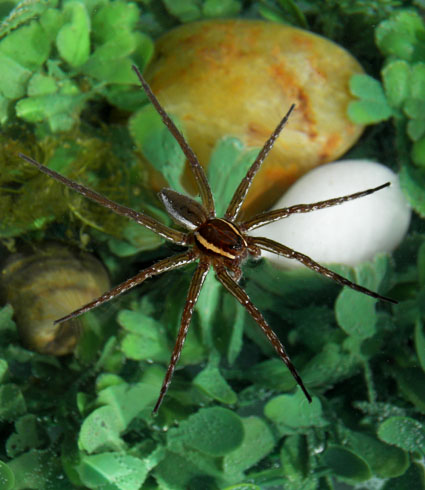
Scientific name: Dolomedes triton.
Common name: six-spotted fishing spider, dock spider.
The six spotted fishing spider is a large spider that looks similar to a wolf spider. They are brown to gray with light spots and areas on the abdomen.
They can grow to 26mm in body length for females and half that size for males. The eight eyes are all equal in size.
15. Northern Yellow Sac Spider

Scientific name: Cheiracanthium mildei.
Common name: Northern yellow sac spider.
The northern yellow sac spider is pale green or tan with dark brown chelicerae and palpi. They can grow to 0.4 inches (10mm) in body length with each leg ending in a double claw. The front legs are double the length of the other legs.
They can be encountered inside and outside of houses.
16. Eastern Parson Spider

Scientific name: Herpyllus ecclesiasticus.
Common name: eastern parson spider.
The Eastern parson spider has a white stripe on its black abdomen that looks like a ruffled necktie the clergymen wore back in the 18th century.
This is a hairy spider of medium size and it’s fast. They are ambush predators and will wander around at night in search of its next meal.
They hide during the day and are often found when lifting boards, debris or rocks.
Their bites are not dangerous, though some people have experienced an allergic reaction to the venom.
17. Arrowhead Orbweaver

Scientific name: Verrucosa arenata.
Common name: triangle orb weaver, arrowhead spider, arrowhead orbweaver.
Arrowhead orbweavers don’t look like other orbweavers of the same family. Orbweavers usually have bulb-shaped abdomens, but the arrowhead has an abdomen that is shaped like an arrow tip.
The abdomen is pointy and triangular in shape with a bright yellow or white triangle stamped on the top. There are also some red markings in the area. The body is a red/brown color.
They create their webs in shady areas and sit in the center of the web hanging upside down.
18. American Green Crab Spider

Scientific name: Misumessus oblongus.
Common name: American Green Crab Spider.
The American green crab spider has the ability to walk in any direction; forwards, backward, and sideways.
Their front legs are very long in comparison to the others, which helps it grab pollinating insects, such as butterflies and bees.
These spiders are usually green and they are tiny in size, so they can hide on a flower petal with ease. Their abdomens are slender with a diamond or kite shape and red banding on the sides.
Further Reading:
19. Long-bodied Cellar Spider

Scientific name: Pholcus phalangioides.
Common name: daddy long-legs spider, long-bodied cellar spider, skull spider.
Long-bodied cellar spiders have an elongated and tube-shaped abdomen. They have a tapered waist with long spindly legs. This spider is often called a Daddy Long Legs.
It’s not uncommon to see this spider bouncing in its web, making it harder to see by observers. They hang upside-down waiting for insects to get entrapped in their webs.
20. Woodlouse Spider

Scientific name: Dysdera crocata.
Common name: woodlouse hunter, sowbug hunter, sowbug killer, pillbug hunter, slater spider.
The woodlouse spider can grow to 15mm for females and 10mm for males. They only have six eyes, where most spiders have eight. They are orange to dark red on the cephalothorax and their legs. Their abdomen is shiny beige, gray, or yellow-brown.
Woodlouse spiders are often found under pot plants, leaf litter, and rocks, always near woodlice. They have been found in homes.
They are active hunters, coming out at night to hunt for prey.
They are known to bite if handled and their bites can cause localized itching.
21. Arabesque Orbweaver

Scientific name: Neoscona arabesca.
Common name: arabesque orbweaver.
Arabesque orbweavers are beautiful orbweavers that vary in color, some are brown or orange, others are gray and some are almost black.
Females have a round abdomen, while males are slender. They have short lines and curved dashes down the center of their abdomens. Then there are thick black commas on the sides of the abdomen, which decrease in size closer to the back.
The female creates circular webs where she hangs upside down in the center waiting for prey to get entrapped. Males are usually seen hiding on branches or leaves close to the female’s web.
22. Common House Spider
Scientific name: Parasteatoda tepidariorum.
Common name: common house spider, American house spider.
Common house spiders create what we know as a cobweb, a messy tangle of a web found in the corner of windows or the attic.
Multiple females may have webs close to each other. They can remain motionless for extended periods waiting for prey to get entangled in their messy webs.
They have long legs with comb-like hairs.
They have a bulb-shaped abdomen which is brown with white and dark patches and lines.
They are not aggressive and even though they will bite, it will only be painful for a couple of days.
23. Dimorphic Jumping Spider

Scientific name: Maevia inclemens.
Common name: Ribbon jumping spider.
This jumping spider has large forelegs and powerful back legs, which allows it to jump more than four times its body length. Their bodies are sparsely covered in hairs with females growing to 0.31 inches (8mm) in body length. She has a brown carapace and pale unmarked legs. The female’s abdomen is rust or chalk color with a black band on each side. Some have chevron markings in the center of the abdomen.
Males are smaller, growing to 0.256 inches (6.5mm) in body length with light to dark brown carapace with a black line around the edge.
Males can be either completely black with white legs and three tufts of bristles on the front of the cephalothorax or gray with a black and white striped body and striped legs with orange pedipalps.
24. Wetland Giant Wolf Spider
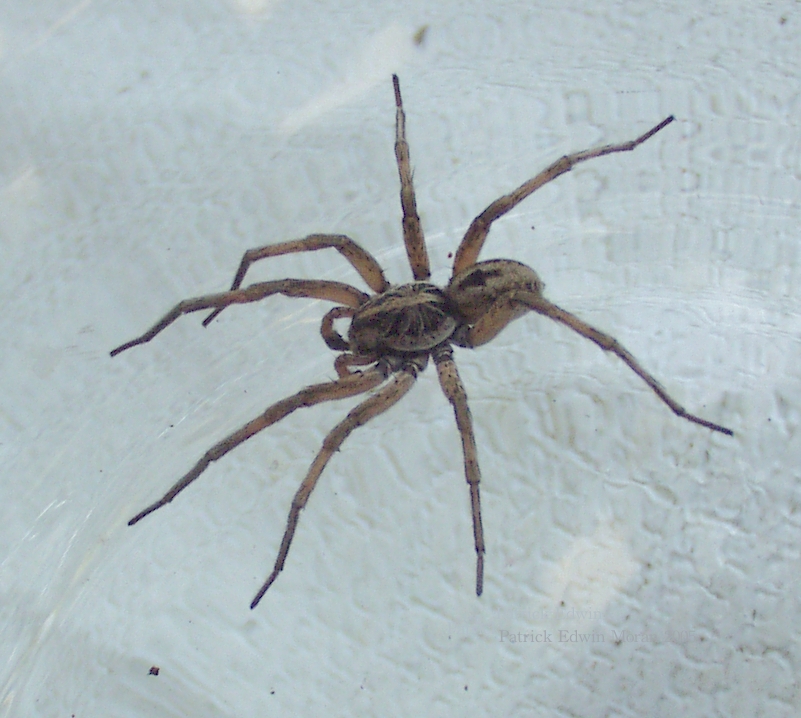
Scientific name: Tigrosa helluo.
Common name: Wetland giant wolf spider.
The wetland giant wolf spider can grow to 1.38 inches (35mm) in body length with eight eyes which are arranged in three rows offering excellent vision.
Females carry their eggs in an egg sac, attached to the end of the abdomen, as she holds her abdomen in a raised position.
They rely on camouflage for protection and are often colored based on their favored habitat. Their underside can vary from yellow to orange or red with black shades.
They hide under rocks and leaf litter and are known to wander into homes.
25. Cross Orbweaver

Scientific name: Araneus diadematus
Common name: European garden spider, diadem spider, orangie, cross spider, crowned orb weaver, pumpkin spider.
Cross orbweavers can vary in color from dark gray to light yellow. They all have white mottled markings on the dorsal abdomen with four or more segments that create a cross.
Females are larger than the male and can grow to 0.79 inches (20mm) in body length, while males grow to 0.51 inches (13mm) in body length.
26. Triangulate Combfoot

Scientific name: Steatoda triangulosa
Common name: triangulate cobweb spider, triangulate bud spider.
Triangular combfoot spiders have a triangular pattern on their abdomen, helping with identification.
They are common house spiders, often found in attics, basements, and outbuildings. They are not aggressive and their venom is not considered medically significant. They spend their day rebuilding their web, which they rely on to entrap their next meal.
27. White-jawed Jumping Spider
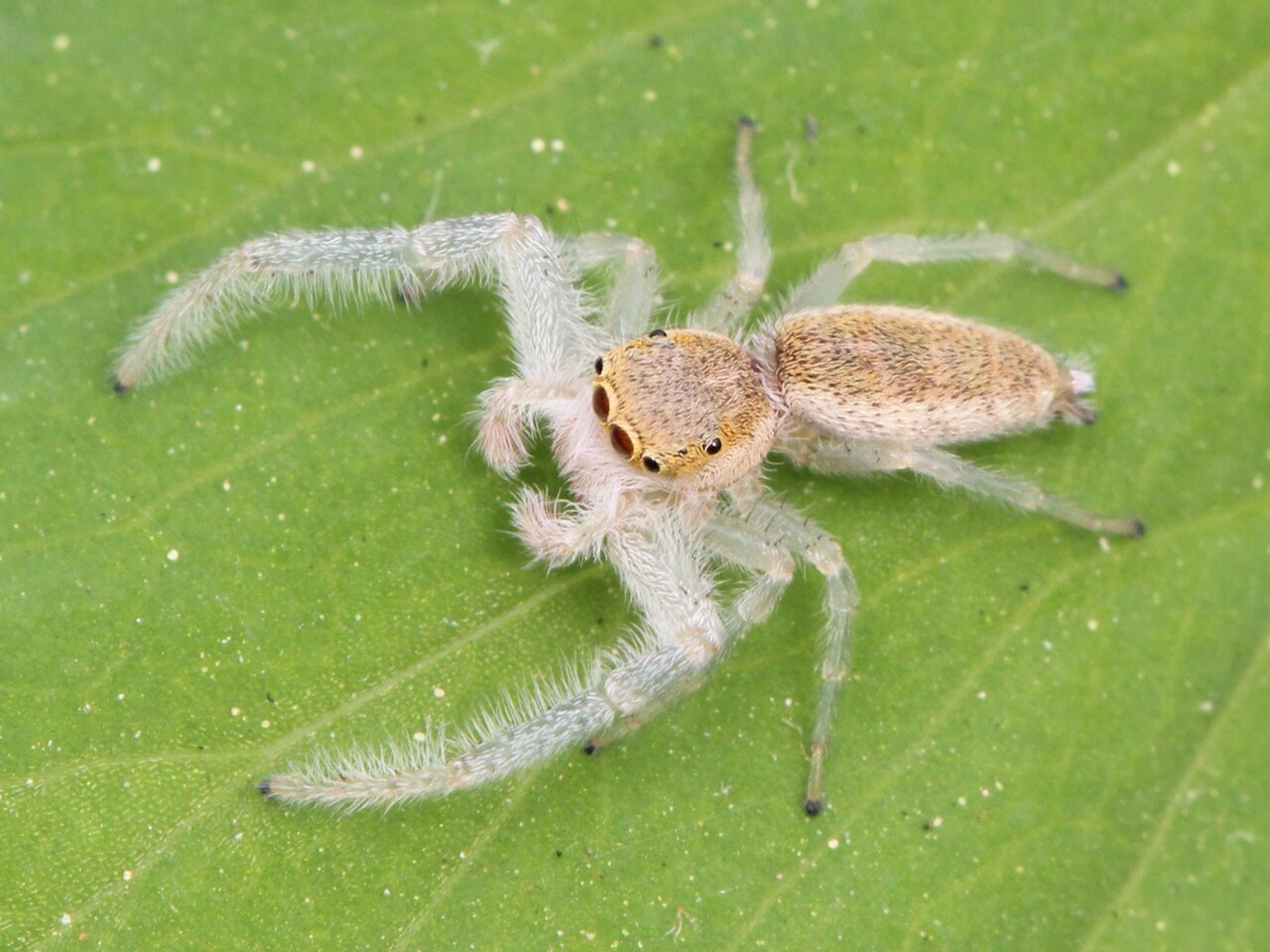
Scientific name: Hentzia mitrata.
Common name: white-jawed jumping spider.
The white jawed jumping spider is a small spider, almost invisible to the human eye unless it moves.
Mitrata, which stands for head dress in Latin, is given to this jumping spider for its crown of red hairs on the male’s head. They are copper in color, with some being black to dark brown.
They are wandering hunters and are often encountered in homes hunting for their next meal.
28. Bowl-and-doily Spider
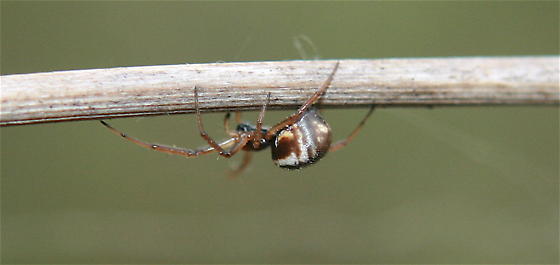
Scientific name: Frontinella pyramitela.
Common name: bowl-and-doily spider.
The bowl and doily spider beings to the sheet weaver family and is common in North America They are small spiders, growing no more than 4mm in body length.
They weave complex sheet web systems with an inverted dome and a bowl suspended above a horizontal sheet.
The spider hangs upside down in the bowl, where they eat small flies and gnats that fall into the non-sticky web.
The bowl and doily spider is red/brown in color with yellow legs. They have decorative white spots on their sides with short hairs.
29. Rabid Wolf Spider

Scientific name: Rabidosa rabida.
Common name: rabid wolf spider.
Rapid wolf spiders are fast and erratic movers, which is where they got their name, but it’s important to note that they do not carry the Rabies virus and are completely harmless to humans.
They are aggressive and they will challenge you, but they are not inclined to bite, rather running away.
They are light brown in color with two dark brown stripes down the sides of the head and one dark brown center line down the abdomen with two thin brown lines on the side of the body.
Their eyes reflect at night. They are active hunters and are known to make their way into homes searching for food.
30. Broad-Faced Sac Spider

Scientific name: Trachelas tranquillus
Common name: broad-faced sac spider
The female broad-faced sac spider can grow to 10mm with males growing to 6mm in body length.
They have thick and hard chelicerae and carapace in red/brown with tiny punctures. The pale yellow to light gray abdomen has a dark dorsal stripe. The front legs are thicker and darker than the others.
They are known to give a painful bite, which is not considered medically significant.
31. Asiatic Wall Jumping Spider

Scientific name: Attulus fasciger
Common name: Asiatic Wall Jumping Spider
The Asiatic wall jumping spider is brown to black in color with eight eyes.
They can grow to 0.16 inches (4mm) in body length. Males tend to be more slender than the female.
They are originally from Asia and were introduced to North America in the 1950s. They live in man-made structures, where they camouflage easily.
32. Striped Fishing Spider
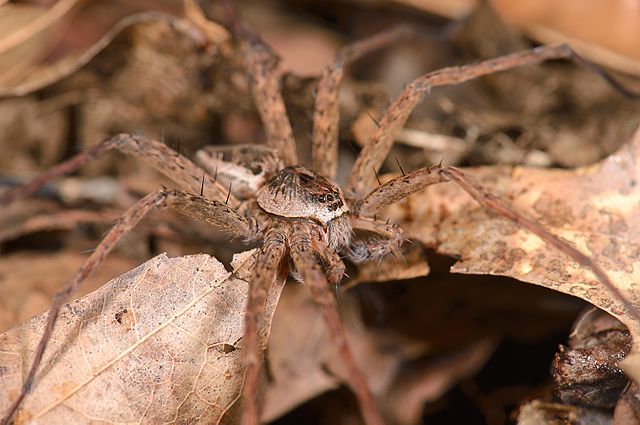
Scientific name: Dolomedes scriptus
Common name: Striped fishing spider
The striped fishing spider can grow to over 6cm in leg span. They are pale brown with light stripes around the legs and down either side of the body.
Males tend to have a white band around the cephalothorax, while the female has a darker band.
33. Arrow-shaped Orbweaver
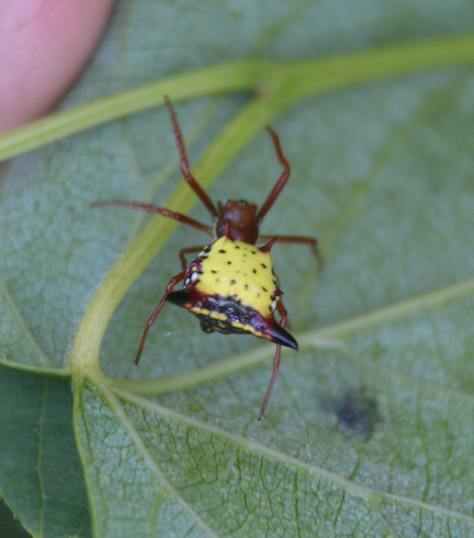
Scientific name: Micrathena sagittata.
Common name: arrow-shaped orbweaver.
The arrow-shaped orbweaver has a triangular and long-shaped abdomen, that resembles the head of an arrow.
The females have sharp spines, almost like rose thorns that are found o the edge of the abdomen.
Males do not have the spines and tend to be mostly black with white edges, while females can range in pattern and color the head and legs, along with most of the body have red.
There is an arrow shape in the center of the abdomen, which is bright yellow with red spots.
They create orb-shaped webs where they hang upside-down waiting for prey to get ensnared.
34. White-banded Crab Spider

Scientific name: Misumenoides formosipes.
Common name: White-banded crab spider.
White banded crab spiders have a white line running through the plane of the eyes.
They are sit-and-wait predators, that prey on pollinators that come to the flower where the spider is waiting.
They have exceptionally strong front legs, which enable them to seize prey, including those much bigger than themselves.
Females vary in color and can change from yellow to white, depending on their surroundings. Males color doesn’t change and is darker in color with a golden abdomen.
The female is larger than the male, growing to 0.44 inches (11.3mm) in body length. Males can grow to 0.13 inches (3.2mm) in body length with longer legs.
35. White-banded Fishing Spider

Scientific name: Dolomedes albineus.
Common name: white-banded fishing spider.
The white-banded fishing spider belongs to the nursery web spider family and is common in the United States.
They tend to hunt close to the water and have hairs that can repel the water, enabling the spider to walk on water or trap air bubbles under its abdomen, so it can dive and swim. They feed mostly on tadpoles and aquatic inverts.
36. Flea Jumping Spider

Scientific name: Naphrys pulex.
Common name: Flea Jumping Spider.
The flea jumping spider is gray and black on the top of their bodies with orange on the sides of the cephalothorax. They reside in tall grass and wooded areas.
They feed on insects and are known to make their way into homes searching for food.
37. Goldenrod Crab Spider

Scientific name: Misumena vatia.
Common name: goldenrod crab spider, flower (crab) spider.
The goldenrod crab spider is commonly found in milkweed and goldenrods. These spiders can walk forwards, backward, and sideways.
Females can grow to 0.39 inches (10mm) in body length, while males only reach half that size.
They are white or yellow or they may be patterned in white and yellow. They can change between these two colors depending on their surroundings.
38. Banded Fishing Spider

Scientific name: Dolomedes vittatus.
Common name: Banded Fishing Spider.
Banded fishing spiders are large, hairy, and fast.
These brown spiders are not aggressive and will often flee if approached.
Males are smaller than the female with a white border on the cephalothorax and abdomen.
They live on aquatic insects and can be encountered close to water. They are large and have been known to eat small fish. They often float on the water with their legs outstretched.
39. Northern Crab Spider

Scientific name: Mecaphesa asperata
Common name: Northern crab spider
Northern crab spiders are also known as flower spiders, hunting for bees and flies that visit colorful flowers.
Their bodies and legs have short stiff spines with a white ocular region. The abdomen has red streaks and mottled brown or a red V-shaped mark near the rear their legs are yellow with the tibia and metatarsus having some red.
40. Brilliant Jumping Spider

Scientific name: Phidippus clarus.
Common name: Brilliant jumping spider.
Brilliant jumping spiders can grow to 0.159 inches (4mm) in body length for females and 0.126 inches (3.2mm) for males.
They are red to brown in color though some are light yellow or brown with darker markings.
They are common in eastern North America where they prefer living in old fields. They sit upside down at the top of plants and jump down to ambush prey.
41. Putnam’s Jumping Spider

Scientific name: Phidippus putnami.
Common name: Putnams jumping spider.
Putnam’s jumping spider can jump more than four times its body length when ambushing prey or escaping predators.
They are hairy with four black tufts of hair just above the eyes and on the sides of the head.
They are ambush predators and will create a web as a retreat. They roam searching for insects where they shoot out a single strand of silk, reducing the risk of the prey escaping.
This spider lives in a range of habitats from forests and gardens to open fields and parking lots. They are known to wander into homes. They are not dangerous.
42. Shamrock Orbweaver
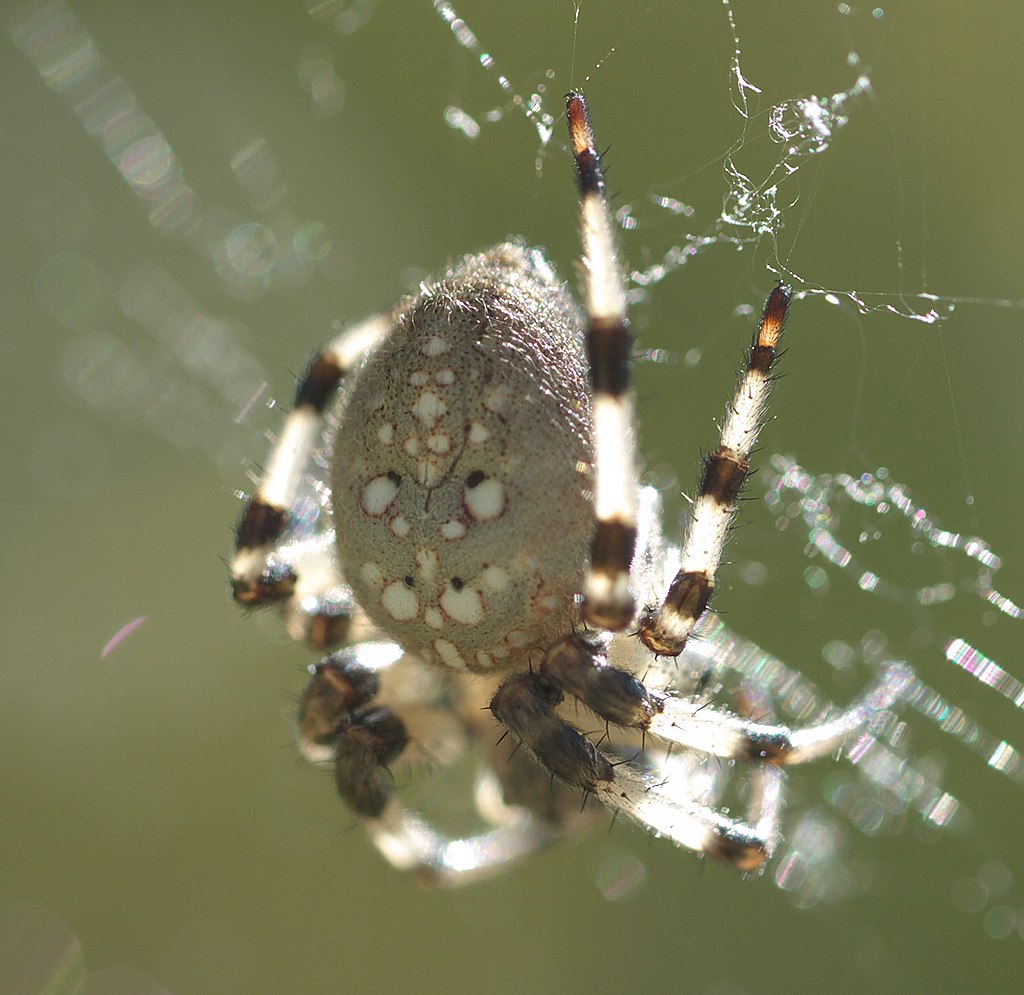
Scientific name: Araneus trifolium
Common name: Shamrock orb weaver
The shamrock orbweaver can be found throughout the United States.
Their abdomens vary in color with most being brown or beige, though there have been reports of some species with green abdomens They have several white dots on their backs with brown or beige legs with white banding at the joints.
They can inflict a painful bite, that is not dangerous to humans.
Further Reading: